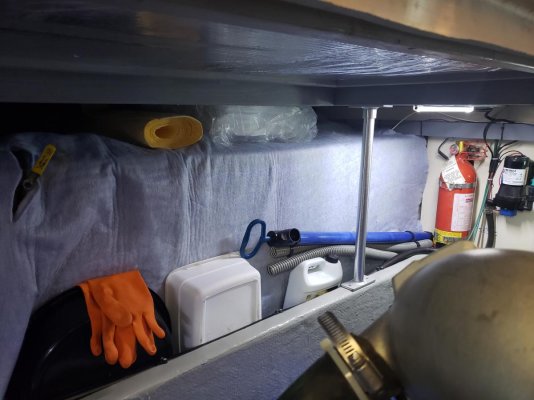jefndeb
Guru
Hello,
I work at an aircraft factory and I am always running across what they consider "scrap" that I would consider "Project Supplies". Another words I dumpster dive. In the completion center, where all the interior is installed following main production, the cabinetry, carpet, additional wiring, pretty much everything it takes to turn a metal tube to a luxury interior is installed. This includes layers of high quality burn proof sound dampening insulation of which I ran across a bunch of.
Another words I dumpster dive. In the completion center, where all the interior is installed following main production, the cabinetry, carpet, additional wiring, pretty much everything it takes to turn a metal tube to a luxury interior is installed. This includes layers of high quality burn proof sound dampening insulation of which I ran across a bunch of.
I figured I might could reduce engine noise in the cabin a little maybe by installing some of this sound dampening insulation in the engine bay area etc.
However sometimes my ideas aren't always good ones in the end but I got to thinking that in doing this could I be introducing a possible an inner fuel tank condensation problem?
I sorta understand condensation, it occurs when warmer air and colder air come together on a surface like a window and as a result the moisture in the air collects on the warmer surface.
So I am thinking this through and say a scenario would be like this-
The engine bay, initially where pretty much everything is roughly the same temp, engine block, transmission, fuel etc. Engine cranks, we get underway and engine area gets pretty hot. As it is now, we have port & starboard 150 gallon SS tanks.
Question is, by me partially covering the 2 tanks loosely with sound dampening insulation, am I increasing the possibility introducing a possible inner fuel tank condensation or not really?
Looking forward to comments...
I work at an aircraft factory and I am always running across what they consider "scrap" that I would consider "Project Supplies".
 Another words I dumpster dive. In the completion center, where all the interior is installed following main production, the cabinetry, carpet, additional wiring, pretty much everything it takes to turn a metal tube to a luxury interior is installed. This includes layers of high quality burn proof sound dampening insulation of which I ran across a bunch of.
Another words I dumpster dive. In the completion center, where all the interior is installed following main production, the cabinetry, carpet, additional wiring, pretty much everything it takes to turn a metal tube to a luxury interior is installed. This includes layers of high quality burn proof sound dampening insulation of which I ran across a bunch of.I figured I might could reduce engine noise in the cabin a little maybe by installing some of this sound dampening insulation in the engine bay area etc.
However sometimes my ideas aren't always good ones in the end but I got to thinking that in doing this could I be introducing a possible an inner fuel tank condensation problem?
I sorta understand condensation, it occurs when warmer air and colder air come together on a surface like a window and as a result the moisture in the air collects on the warmer surface.
So I am thinking this through and say a scenario would be like this-
The engine bay, initially where pretty much everything is roughly the same temp, engine block, transmission, fuel etc. Engine cranks, we get underway and engine area gets pretty hot. As it is now, we have port & starboard 150 gallon SS tanks.
Question is, by me partially covering the 2 tanks loosely with sound dampening insulation, am I increasing the possibility introducing a possible inner fuel tank condensation or not really?
Looking forward to comments...




